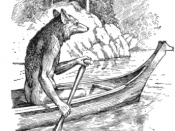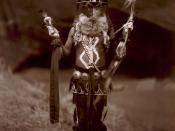COYOTE THE TRICKSTER IN NAVAJO FOLKLORE
The trickster is a very important part of Navajo oral tradition and can assume many forms. Though the form he takes varies from story to story, the cultural lessons with regard to virtue and morals that this character teaches are invaluable in preserving Navajo culture. With passing stories of coyote the trickster on to new generations, the Navajo are able to teach their children important lessons in a fun way. Through the generations Coyote's role has been the same, to teach children that there are consequences when a person strays from good morals and behavior.
Sometimes the trickster character as coyote is portrayed as imitative, stupid, greedy, and deceitful (Heffern). He attempt to be tricky in many different forms, but also seems to get tricked himself by those who can see through his immoral tricks. Coyote can assume many other shapes such as other animal, people and objects (Hynes).
Because of this, it is always best for people to be on their best behavior. Coyote is a survivor and has the power to adapt quickly to change using his wits. He is always waiting for his next chance to try and corrupt some innocent person, usually a youngster.
The Navajo the view of Coyote is generally a very negative one, related to death and witchcraft (Hynes). Coyote is often associated with First Mans group who are also thought of negatively due to being associated with evil (Gill 143). Witches pray to Coyote and are said to be able to turn into a Coyote, so he is guilty by association (Bever). The negative things associated with witches in the Navajo community, those of greed, promiscuity, meanness, etc., are also then associated with Coyote (Bever).
Coyote's power is also associated with war and hunting. Because...


